初三英语知识点归纳
- 格式:docx
- 大小:41.84 KB
- 文档页数:19
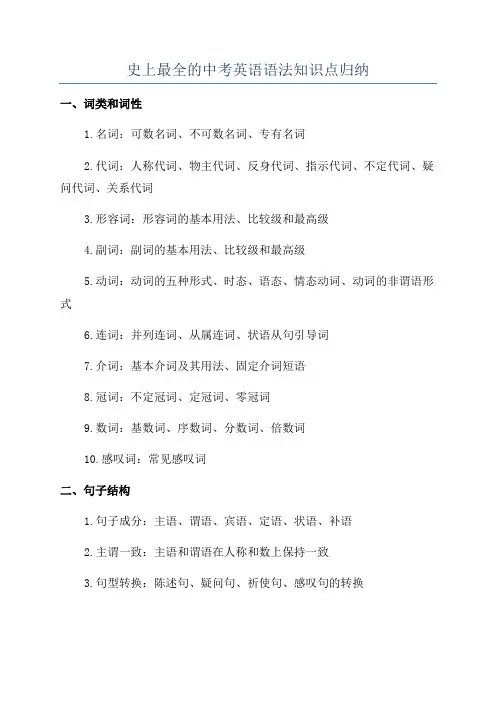
史上最全的中考英语语法知识点归纳一、词类和词性1.名词:可数名词、不可数名词、专有名词2.代词:人称代词、物主代词、反身代词、指示代词、不定代词、疑问代词、关系代词3.形容词:形容词的基本用法、比较级和最高级4.副词:副词的基本用法、比较级和最高级5.动词:动词的五种形式、时态、语态、情态动词、动词的非谓语形式6.连词:并列连词、从属连词、状语从句引导词7.介词:基本介词及其用法、固定介词短语8.冠词:不定冠词、定冠词、零冠词9.数词:基数词、序数词、分数词、倍数词10.感叹词:常见感叹词二、句子结构1.句子成分:主语、谓语、宾语、定语、状语、补语2.主谓一致:主语和谓语在人称和数上保持一致3.句型转换:陈述句、疑问句、祈使句、感叹句的转换4.句子的简单句、并列句、复合句、复合句类型(定语从句、状语从句、宾语从句)三、时态和语态1.一般现在时2.一般过去时3.现在进行时4.过去进行时5.一般将来时6.一般过去将来时7.现在完成时8.过去完成时9.现在完成进行时10.一般过去完成进行时11.被动语态四、非谓语动词1.不定式2.动名词3.动词-ing形式五、虚拟语气1.与事实相反的虚拟语气:与现在事实相反的虚拟语气、与过去事实相反的虚拟语气2.与将来事实相反的虚拟语气3.与现在条件相反的虚拟语气4.与过去条件相反的虚拟语气六、定语从句1.关系代词引导的定语从句2.关系副词引导的定语从句3.定语从句的嵌套七、状语从句1.时间状语从句2.地点状语从句3.方式状语从句4.原因状语从句5.条件状语从句6.比较状语从句7.目的状语从句8.结果状语从句八、宾语从句1.宾语从句的引导词2.宾语从句的位置九、名词性从句1.主语从句2.宾语从句3.表语从句十、情态动词1.can和could2.may和might3.will和would4.shall和should5.must和have to6.need和dare以上是中考英语语法知识点的简要归纳,更详细的内容需要根据课本和学习资料进行学习和理解。
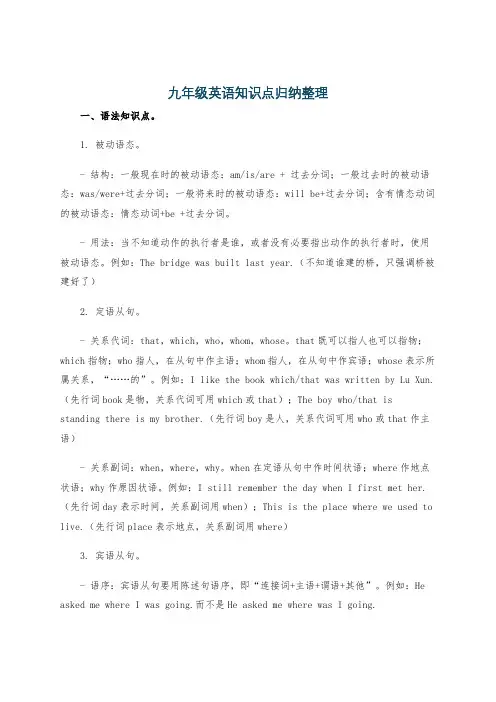
九年级英语知识点归纳整理一、语法知识点。
1. 被动语态。
- 结构:一般现在时的被动语态:am/is/are + 过去分词;一般过去时的被动语态:was/were+过去分词;一般将来时的被动语态:will be+过去分词;含有情态动词的被动语态:情态动词+be +过去分词。
- 用法:当不知道动作的执行者是谁,或者没有必要指出动作的执行者时,使用被动语态。
例如:The bridge was built last year.(不知道谁建的桥,只强调桥被建好了)2. 定语从句。
- 关系代词:that,which,who,whom,whose。
that既可以指人也可以指物;which指物;who指人,在从句中作主语;whom指人,在从句中作宾语;whose表示所属关系,“……的”。
例如:I like the book which/that was written by Lu Xun.(先行词book是物,关系代词可用which或that);The boy who/that is standing there is my brother.(先行词boy是人,关系代词可用who或that作主语)- 关系副词:when,where,why。
when在定语从句中作时间状语;where作地点状语;why作原因状语。
例如:I still remember the day when I first met her.(先行词day表示时间,关系副词用when);This is the place where we used to live.(先行词place表示地点,关系副词用where)3. 宾语从句。
- 语序:宾语从句要用陈述句语序,即“连接词+主语+谓语+其他”。
例如:He asked me where I was going.而不是He asked me where was I going.- 连接词:that(无意义,可省略,在从句中不作成分);if/whether(“是否”,在从句中不作成分);特殊疑问词(如what,when,where,why,how等,在从句中作相应的成分)。
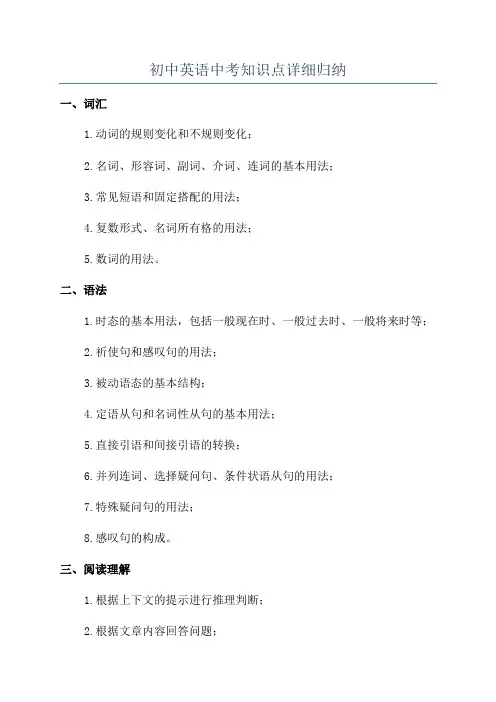
初中英语中考知识点详细归纳
一、词汇
1.动词的规则变化和不规则变化;
2.名词、形容词、副词、介词、连词的基本用法;
3.常见短语和固定搭配的用法;
4.复数形式、名词所有格的用法;
5.数词的用法。
二、语法
1.时态的基本用法,包括一般现在时、一般过去时、一般将来时等;
2.祈使句和感叹句的用法;
3.被动语态的基本结构;
4.定语从句和名词性从句的基本用法;
5.直接引语和间接引语的转换;
6.并列连词、选择疑问句、条件状语从句的用法;
7.特殊疑问句的用法;
8.感叹句的构成。
三、阅读理解
1.根据上下文的提示进行推理判断;
2.根据文章内容回答问题;
3.理解文章的主旨大意;
4.理解故事情节、人物性格、动作等。
四、听力
1.听懂对话、短文等基本信息;
2.根据听到的问题选择正确答案;
3.根据听到的对话或短文判断正误;
4.根据听到的对话或短文选择合适的图片。
五、写作
1.根据提供的提示或问题写作;
2.根据所给的素材进行写作;
3.书写规范,包括大小写、标点符号等;
4.语法正确、上下文连贯。
六、听说能力
1.参与简单的对话和问答;
2.能正确发音和拼写常见的单词;
3.能用正确的语音语调表达自己的需求和意愿。
七、其他
1.简单的英语国家的文化知识;
2.常见的英语国家的地理位置和名胜古迹;
3.了解英语国家的风俗习惯和节日。
以上是初中英语中考的知识点的详细归纳,包括词汇、语法、阅读理解、听力等多个方面。
考生可以针对这些知识点进行备考,提高自己的英语水平,取得好成绩。
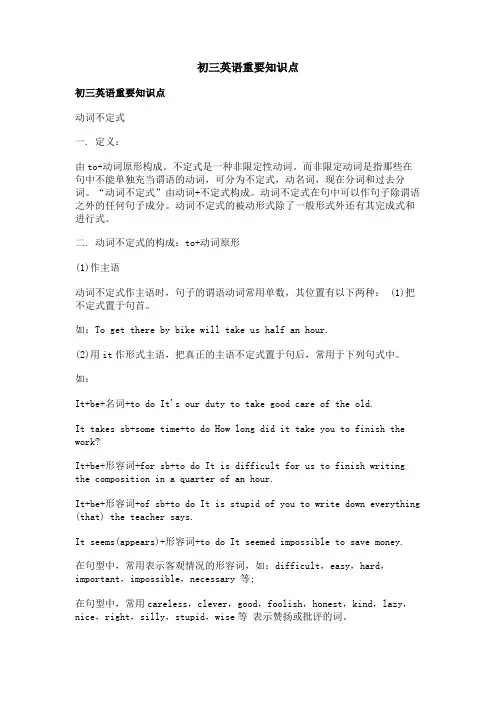
初三英语重要知识点初三英语重要知识点动词不定式一. 定义:由to+动词原形构成。
不定式是一种非限定性动词。
而非限定动词是指那些在句中不能单独充当谓语的动词,可分为不定式,动名词,现在分词和过去分词。
“动词不定式”由动词+不定式构成。
动词不定式在句中可以作句子除谓语之外的任何句子成分。
动词不定式的被动形式除了一般形式外还有其完成式和进行式。
二. 动词不定式的构成:to+动词原形(1)作主语动词不定式作主语时,句子的谓语动词常用单数,其位置有以下两种: (1)把不定式置于句首。
如:To get there by bike will take us half an hour.(2)用it作形式主语,把真正的主语不定式置于句后,常用于下列句式中。
如:It+be+名词+to do It's our duty to take good care of the old.It takes sb+some time+to do How long did it take you to finish the work?It+be+形容词+for sb+to do It is difficult for us to finish writing the composition in a quarter of an hour.It+be+形容词+of sb+to do It is stupid of you to write down everything (that) the teacher says.It seems(appears)+形容词+to do It seemed impossible to save money.在句型中,常用表示客观情况的形容词,如:difficult,easy,hard,important,impossible,necessary 等;在句型中,常用careless,clever,good,foolish,honest,kind,lazy,nice,right,silly,stupid,wise等表示赞扬或批评的词。
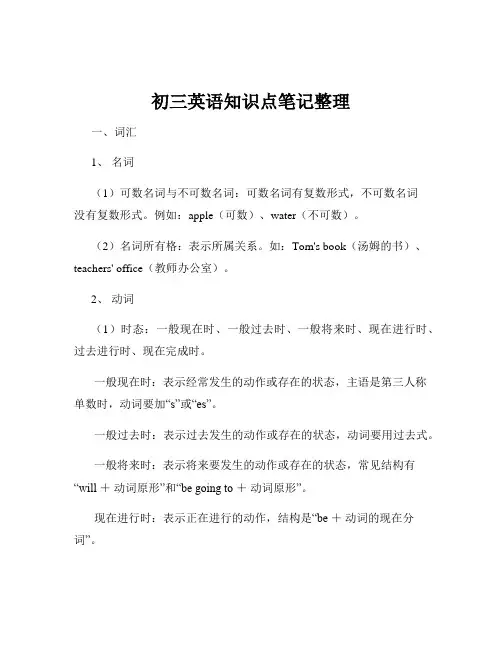
初三英语知识点笔记整理一、词汇1、名词(1)可数名词与不可数名词:可数名词有复数形式,不可数名词没有复数形式。
例如:apple(可数)、water(不可数)。
(2)名词所有格:表示所属关系。
如:Tom's book(汤姆的书)、teachers' office(教师办公室)。
2、动词(1)时态:一般现在时、一般过去时、一般将来时、现在进行时、过去进行时、现在完成时。
一般现在时:表示经常发生的动作或存在的状态,主语是第三人称单数时,动词要加“s”或“es”。
一般过去时:表示过去发生的动作或存在的状态,动词要用过去式。
一般将来时:表示将来要发生的动作或存在的状态,常见结构有“will +动词原形”和“be going to +动词原形”。
现在进行时:表示正在进行的动作,结构是“be +动词的现在分词”。
过去进行时:表示过去某个时刻正在进行的动作,结构是“was/were +动词的现在分词”。
现在完成时:表示过去发生的动作对现在造成的影响或结果,结构是“have/has +过去分词”。
(2)动词短语:如 look after(照顾)、put on(穿上)等。
3、形容词和副词(1)比较级和最高级:形容词和副词都有比较级和最高级形式,用于比较程度的不同。
规则变化:一般在词尾加“er”“est”;以“e”结尾的加“r”“st”;重读闭音节词双写末尾字母再加“er”“est”;多音节词和部分双音节词在前面加“more”“most”。
不规则变化:如 good better best,bad worse worst 等。
(2)形容词修饰名词,副词修饰动词、形容词和其他副词。
4、代词(1)人称代词:主格(I, you, he, she, it, we, they)和宾格(me, you, him, her, it, us, them)。
(2)物主代词:形容词性物主代词(my, your, his, her, its, our, their)和名词性物主代词(mine, yours, his, hers, its, ours, theirs)。
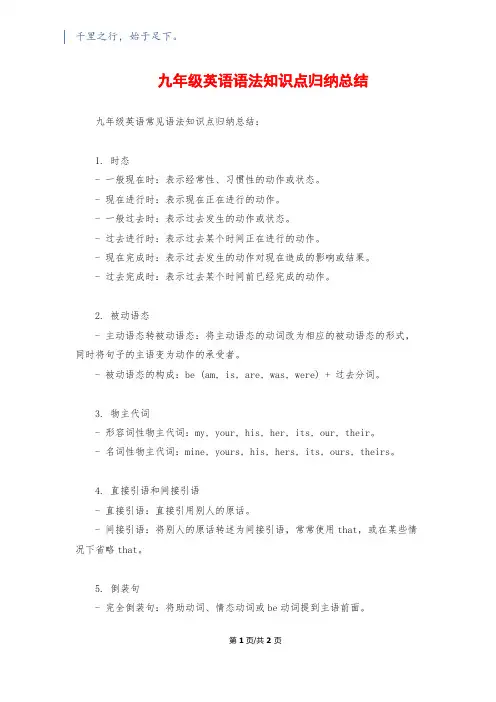
千里之行,始于足下。
九年级英语语法知识点归纳总结九年级英语常见语法知识点归纳总结:1. 时态- 一般现在时:表示经常性、习惯性的动作或状态。
- 现在进行时:表示现在正在进行的动作。
- 一般过去时:表示过去发生的动作或状态。
- 过去进行时:表示过去某个时间正在进行的动作。
- 现在完成时:表示过去发生的动作对现在造成的影响或结果。
- 过去完成时:表示过去某个时间前已经完成的动作。
2. 被动语态- 主动语态转被动语态:将主动语态的动词改为相应的被动语态的形式,同时将句子的主语变为动作的承受者。
- 被动语态的构成:be (am, is, are, was, were) + 过去分词。
3. 物主代词- 形容词性物主代词:my, your, his, her, its, our, their。
- 名词性物主代词:mine, yours, his, hers, its, ours, theirs。
4. 直接引语和间接引语- 直接引语:直接引用别人的原话。
- 间接引语:将别人的原话转述为间接引语,常常使用that,或在某些情况下省略that。
5. 倒装句- 完全倒装句:将助动词、情态动词或be动词提到主语前面。
第1页/共2页锲而不舍,金石可镂。
- 部分倒装句:将助动词或be动词提到动词前面。
6. 从句- 名词性从句:在句子中充当名词的成分。
- 定语从句:在句子中充当定语的成分。
- 状语从句:在句子中充当状语的成分。
7. 并列连词和从属连词- 并列连词:连接意义相同的并列分句,如and, but, or, so等。
- 从属连词:连接主句与从句,如if, when, because, although等。
以上是九年级英语常见的语法知识点总结,希望能对你有所帮助!。
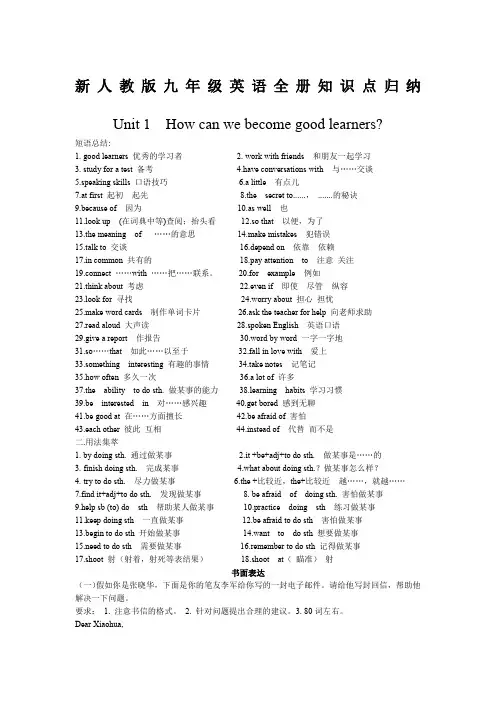
新人教版九年级英语全册知识点归纳Unit 1 How can we become good learners?短语总结:1. good learners 优秀的学习者2. work with friends 和朋友一起学习3. study for a test 备考4.have conversations with 与……交谈5.speaking skills 口语技巧6.a little 有点儿7.at first 起初起先8.the secret to......,.......的秘诀9.because of 因为10.as well 也11.look up (在词典中等)查阅;抬头看12.so that 以便,为了13.the meaning of ……的意思14.make mistakes 犯错误15.talk to 交谈16.depend on 依靠依赖17.in common 共有的18.pay attention to 注意关注19.connect ……with ……把……联系。
20.for example 例如21.think about 考虑22.even if 即使尽管纵容23.look for 寻找24.worry about 担心担忧25.make word cards 制作单词卡片26.ask the teacher for help 向老师求助27.read aloud 大声读28.spoken English 英语口语29.give a report 作报告30.word by word 一字一字地31.so……that 如此……以至于32.fall in love with 爱上33.something interesting 有趣的事情34.take notes 记笔记35.how often 多久一次36.a lot of 许多37.the ability to do sth. 做某事的能力38.learning habits 学习习惯39.be interested in 对……感兴趣40.get bored 感到无聊41.be good at 在……方面擅长42.be afraid of 害怕43.each other 彼此互相44.instead of 代替而不是二.用法集萃1. by doing sth. 通过做某事2.it +be+adj+to do sth. 做某事是……的3.finish doing sth. 完成某事4.what about doing sth.?做某事怎么样?4.try to do sth. 尽力做某事 6.the +比较近,the+比较近越……,就越……7.find it+adj+to do sth. 发现做某事8. be afraid of doing sth. 害怕做某事9.help sb (to) do sth 帮助某人做某事10.practice doing sth 练习做某事11.keep doing sth 一直做某事12.be afraid to do sth 害怕做某事13.begin to do sth 开始做某事14.want to do sth 想要做某事15.need to do sth 需要做某事16.remember to do sth 记得做某事17.shoot 射(射着,射死等表结果)18.shoot at(瞄准)射书面表达(一)假如你是张晓华,下面是你的笔友李军给你写的一封电子邮件。
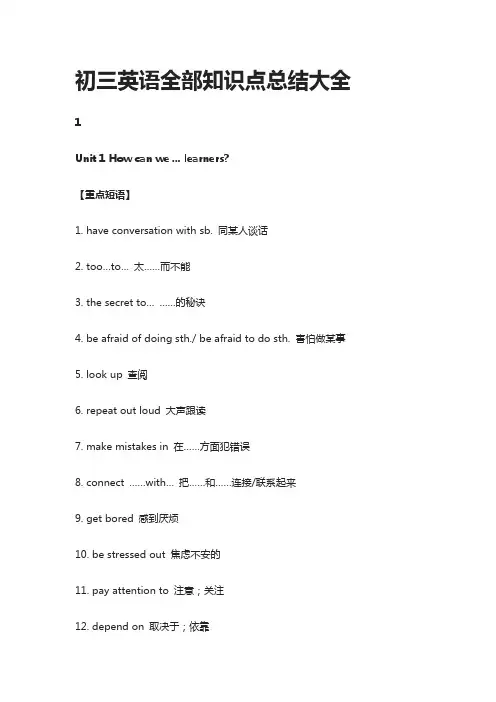
初三英语全部知识点总结大全1Unit 1 How can we ... learners?【重点短语】1. have conversation with sb. 同某人谈话2. too…to…太……而不能3. the secret to………的秘诀4. be afraid of doing sth./ be afraid to do sth. 害怕做某事5. look up 查阅6. repeat out loud 大声跟读7. make mistakes in 在……方面犯错误8. connect ……with…把……和……连接/联系起来9. get bored 感到厌烦10. be stressed out 焦虑不安的11. pay attention to 注意;关注12. depend on 取决于;依靠13. the ability to do sth.. 做某事的能力【考点详解】1. by + doing 通过……方式(by是介词,后面要跟动名词,也就是动词的ing 形式)2. talk about 谈论,议论,讨论The students often talk about movie after class. 学生们常常在课后讨论电影。
talk to sb= talk with sb 与某人说话3. 提建议的句子:①What/ how about +doing sth.? 做…怎么样?(about后面要用动词的ing 形式,这一点考试考的比较多)如:What/ How about going shopping?②Why don't you + do sth.? 你为什么不做…?如:Why don't you go shopping?③Why not + do sth. ? 为什么不做…?如:Why not go shopping?④Let's + do sth. 让我们做…...吧。
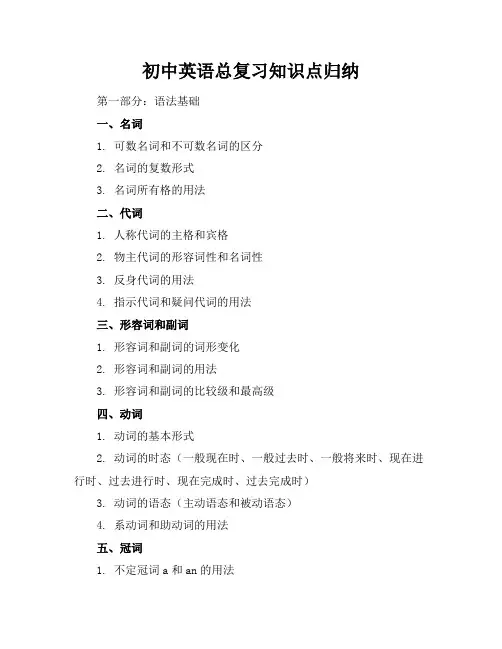
初中英语总复习知识点归纳第一部分:语法基础一、名词1. 可数名词和不可数名词的区分2. 名词的复数形式3. 名词所有格的用法二、代词1. 人称代词的主格和宾格2. 物主代词的形容词性和名词性3. 反身代词的用法4. 指示代词和疑问代词的用法三、形容词和副词1. 形容词和副词的词形变化2. 形容词和副词的用法3. 形容词和副词的比较级和最高级四、动词1. 动词的基本形式2. 动词的时态(一般现在时、一般过去时、一般将来时、现在进行时、过去进行时、现在完成时、过去完成时)3. 动词的语态(主动语态和被动语态)4. 系动词和助动词的用法五、冠词1. 不定冠词a和an的用法2. 定冠词the的用法3. 不使用冠词的情况六、连词1. 并列连词的用法2. 从属连词的用法七、介词1. 常用介词的用法2. 介词短语的结构和用法八、数词1. 基数词和序数词的用法2. 分数、小数和百分数的表达九、感叹词1. 感叹词的用法十、疑问词1. 疑问词的用法十一、句型结构1. 简单句的五种基本句型2. 并列句和复合句的结构和用法十二、主谓一致1. 主谓一致的原则2. 主谓一致的特殊情况十三、倒装句1. 完全倒装和部分倒装的区别2. 常见的倒装句型十四、省略句1. 省略句的结构和用法十五、强调句1. 强调句的结构和用法十六、虚拟语气1. 虚拟语气的用法十七、情态动词1. 情态动词的用法十八、非谓语动词1. 非谓语动词的分类和用法十九、固定搭配1. 常见的固定搭配二十、习惯用语和俚语1. 常见的习惯用语和俚语第二部分:词汇与短语一、词汇记忆方法1. 词根词缀记忆法2. 同义词和反义词记忆法3. 分类记忆法4. 联想记忆法二、常见词汇和短语1. 常用动词短语2. 常用形容词短语3. 常用介词短语4. 常用连词短语5. 常用固定搭配三、词汇辨析1. 形近词辨析2. 意思相近的词辨析3. 语境辨析四、词汇应用1. 词汇在句子中的应用2. 词汇在段落中的应用3. 词汇在文章中的应用五、词汇扩展1. 通过阅读扩展词汇2. 通过听力扩展词汇3. 通过口语和写作扩展词汇六、词汇复习策略1. 制定词汇复习计划2. 定期进行词汇测试3. 反复记忆和复习第三部分:阅读理解一、阅读技巧1. 快速阅读2. 精读3. 猜词技巧4. 理解文章主旨和大意5. 找出文章中的细节信息二、阅读题型1. 主旨大意题2. 细节理解题3. 推理判断题4. 词义猜测题5. 观点态度题三、阅读材料1. 故事类文章2. 议论文3. 说明文4. 应用文5. 新闻报道四、阅读理解策略1. 预览文章和首段2. 扫读文章找出关键词3. 仔细阅读理解文章内容4. 回答问题时注意关键词和语境5. 验证答案是否符合文章内容第四部分:写作技能一、写作技巧1. 确定写作目的和主题2. 拟定写作提纲3. 运用适当的句型和词汇4. 保持文章逻辑清晰5. 注意文章格式和标点符号二、写作题型1. 记叙文2. 议论文3. 说明文4. 应用文5. 日记和书信三、写作素材1. 人物描写2. 地点描写3. 事件描写4. 情感表达5. 观点陈述四、写作策略1. 多读优秀范文2. 多练习写作3. 请教老师和同学4. 反复修改和润色5. 保持写作兴趣和热情第五部分:听力理解一、听力技巧1. 预测听力内容2. 抓住关键词和关键信息4. 边听边记笔记5. 理解对话和独白的逻辑关系二、听力题型1. 简单听力理解题2. 听力细节理解题3. 听力推理判断题4. 听力主旨大意题5. 听力词义猜测题三、听力材料1. 对话2. 独白3. 新闻报道4. 广播节目5. 电影和电视剧片段四、听力理解策略1. 预览问题和选项2. 仔细听录音,注意关键词3. 根据听力内容进行推理和判断4. 选择最符合听力内容的答案5. 检查答案是否符合题意第六部分:口语表达一、口语技巧1. 准备话题和内容3. 保持语速适中4. 注意语法和词汇的准确性5. 保持自信和流畅二、口语题型1. 自我介绍2. 话题讨论3. 角色扮演4. 观点陈述5. 回答问题三、口语素材1. 日常生活话题2. 学校生活话题3. 社会热点话题4. 个人兴趣爱好话题5. 旅游和文化话题四、口语表达策略1. 多听多说,提高口语能力2. 模仿优秀的口语表达3. 与老师和同学进行口语练习4. 参加英语角和口语比赛5. 记录自己的口语表达,进行反思和改进第七部分:综合技能一、综合技巧1. 综合运用语法、词汇、阅读、写作、听力和口语等技能2. 注重语言的实际运用能力3. 提高语言的综合运用水平4. 培养跨文化交际能力5. 保持学习英语的兴趣和动力二、综合题型1. 完形填空2. 阅读理解3. 写作4. 听力理解5. 口语表达三、综合复习策略1. 制定综合复习计划2. 定期进行综合测试3. 反复练习和复习4. 请教老师和同学5. 保持学习英语的兴趣和热情。
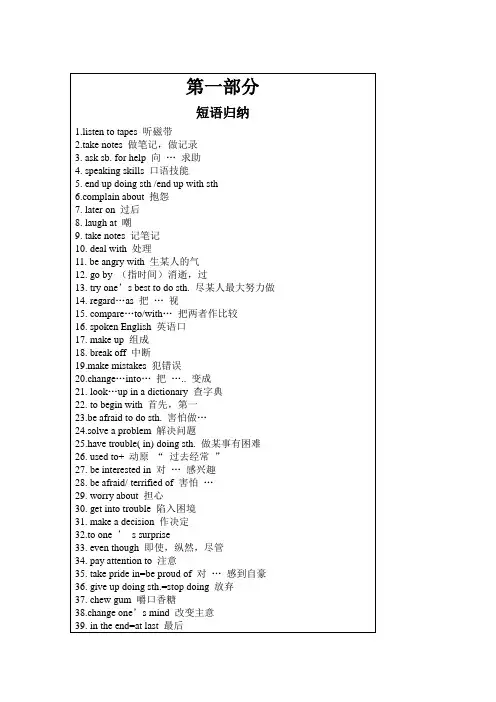
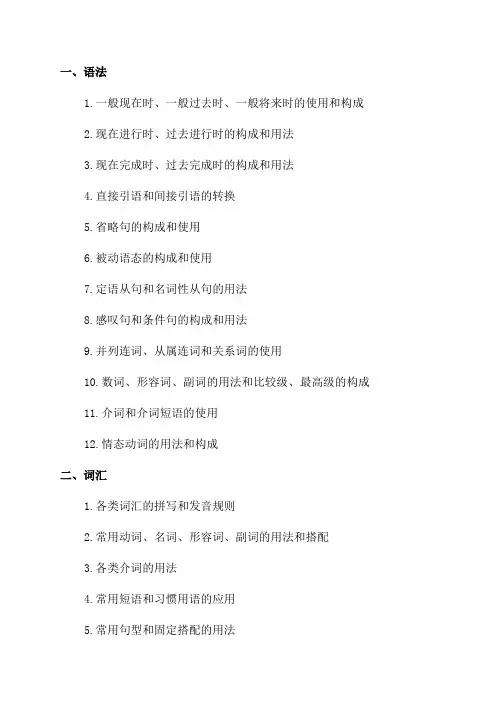
一、语法
1.一般现在时、一般过去时、一般将来时的使用和构成
2.现在进行时、过去进行时的构成和用法
3.现在完成时、过去完成时的构成和用法
4.直接引语和间接引语的转换
5.省略句的构成和使用
6.被动语态的构成和使用
7.定语从句和名词性从句的用法
8.感叹句和条件句的构成和用法
9.并列连词、从属连词和关系词的使用
10.数词、形容词、副词的用法和比较级、最高级的构成
11.介词和介词短语的使用
12.情态动词的用法和构成
二、词汇
1.各类词汇的拼写和发音规则
2.常用动词、名词、形容词、副词的用法和搭配
3.各类介词的用法
4.常用短语和习惯用语的应用
5.常用句型和固定搭配的用法
三、阅读理解
1.根据文章的标题、首句、尾句、关键词等进行文章的整体理解
2.根据上下文和词汇推测词义
3.理解和分析文章中的事实细节和主旨
4.分析和解答文章中的推理和引申问题
5.根据文章内容回答问题、总结归纳并进行有关话题的讨论
四、写作
1.根据提示和要求进行句子、短文的写作
2.根据图片或图表进行写作并描述所给信息
3.根据所学内容进行自由写作并流畅表达自己的观点
4.根据所给材料和要求进行信件、日记、倒序叙述等不同文体的写作
5.使用复杂句型和连接词进行段落和篇章的组织和衔接
以上仅是九年级全册英语知识点的一部分,每个单元和课文中还涉及很多具体的语法点、词汇和表达方式。
在学习过程中,应该结合课本和习题进行练习和巩固,才能更好地掌握这些知识点。
同时,还需要注重拓宽自己的阅读广度和写作能力,提高语言的运用和表达能力。
中考英语知识点归纳汇总-详细第一课时名词一、概述1、名词的属性:表示人或事物的名称抽象概念的词叫名词。
2、名词分普通名词和专有名词。
普通名词是表示某一类人或事物,或某种物体或抽象概念的名称。
如:teacher, desks, plates, milk, box等,专有名词表示某一特定的人、事物、地方团体、党派、国家机关、语言、节日等专用的名称。
(运用)如:China, Chinese, Saturday, June, Green, Beijing, Olympic等。
(专有名词的第一个字母要大写)二、可数名词与不可数名词1、可数名词是指表示人或事物,可以用数来计量的名词,有单复数之分。
如:glass-----glasses; book---- books2、不可数名词是指所表示的事物不能用数来计量。
如:paper, rice, water , milk, tea等。
3、有些名词在特定情况下由不可数变为可数名词。
Light travels faster than sound; (light:光线,不可数)The lights are on. (light:灯,可数)4、不可数名词的量的表示不可数名词一般无法用数来计算,前面不能用a或an或数词来表示数量,它的量往往借助于容器来表示。
如:a glass of milk ------ four glasses of milka piece of paper------two pieces of papera bag of rice------three bags of rice三、可数名词的复数形式(识记、运用)1、可数名词在应用时有单复数之分,单数变复数有规则变化和不规则变化两种。
规则变化情况变化形式例词一般情况加-sgirls; books;以s,x,ch,sh结尾的名词加-esclasses; boxes; watches;brushes以辅音字母加y结尾的名词变y为i, 加escity---cities; baby---babies以f或fe结尾的名词变f,fe为v, 加esknife---knives; leaf---leaves以O结尾的名词potatoes; tomatoes;photos; kilos; bamboos; radios 2、少数名词有不规则的变化形式policeman---policemen; man---men; woman---women; tooth---teeth; foot---feet; sheep---sheep; deer---deer; Japanese--- Japanese; Chinese --- Chinese; fish --- fish 四、名词所有格(运用)名词的所有格是表示所有关系的形式,它也有构成上的变化。
初三英语必背知识点总结(经典版)编制人:__________________审核人:__________________审批人:__________________编制单位:__________________编制时间:____年____月____日序言下载提示:该文档是本店铺精心编制而成的,希望大家下载后,能够帮助大家解决实际问题。
文档下载后可定制修改,请根据实际需要进行调整和使用,谢谢!并且,本店铺为大家提供各种类型的经典范文,如演讲稿、总结报告、合同协议、方案大全、工作计划、学习计划、条据书信、致辞讲话、教学资料、作文大全、其他范文等等,想了解不同范文格式和写法,敬请关注!Download tips: This document is carefully compiled by this editor. I hope that after you download it, it can help you solve practical problems. The document can be customized and modified after downloading, please adjust and use it according to actual needs, thank you!In addition, this shop provides you with various types of classic sample essays, such as speech drafts, summary reports, contract agreements, project plans, work plans, study plans, letter letters, speeches, teaching materials, essays, other sample essays, etc. Want to know the format and writing of different sample essays, so stay tuned!初三英语必背知识点总结学习好初中英语,为我们未来的学英语之路走得更加轻松。
九年级英语知识点总结归纳在九年级学习英语的过程中,我们接触到了许多知识点。
下面我将对这些知识点进行总结和归纳,以帮助大家更好地复习和掌握。
一、语法知识点1. 过去进行时:表示过去某一时间点或动作进行中的状态,构成:was/were + 动词-ing。
例如:I was reading a book when she called me.2. 被动语态:表示主语是动作的承受者,构成:be + 过去分词。
例如:The letter was written by Peter.3. if条件句:表示假设条件和可能的结果,主要分为三种类型:零条件句、一条件句和二条件句。
例如:If it rains tomorrow, wewill stay at home.4. 直接引语和间接引语:直接引语是直接引述别人的话,用引号括起来;间接引语是转述别人的话,不用引号。
例如:He said, "I am busy now." → He said that he was busy then.5. 同位语从句:用来解释、补充或重申名词的内容,常用连词有that, whether, if等。
例如:He has no idea whether it will rain or not.二、词汇知识点1. 同义词和反义词:同义词指意思相近或相同的词语,例如:happy - glad;反义词指意思相反的词语,例如:big - small。
2. 动词词组:一些动词和介词搭配使用,构成常用的动词短语,例如:look forward to, give up, talk about等。
3. 常用短语动词:由动词和副词、介词或两者组合而成,具有固定的意义,例如:pick up, look after, take off等。
4. 习惯用语和俚语:指在特定场合和特定上下文中常用的固定搭配,例如:break a leg, a piece of cake等。
中考英语知识点总结归纳完整版1.语法知识点:-时态:一般现在时、一般过去时、一般将来时等;-祈使句和感叹句的构成;-陈述句、疑问句、否定句等的构成;-直接引语和间接引语的转换;-名词、动词、形容词、副词、介词等的用法;-句子成分的划分:主语、谓语、宾语、定语、状语、表语等。
2.词汇知识点:- 常见动词短语:take care of、look forward to、get along with等;- 常见形容词和副词:beautiful、interesting、quickly、carefully等;- 常见连词和介词:and、but、so、because、in、on、at等;- 常见名词:teacher、student、friend、book、house等;- 常见短语:in the morning、at the airport、go to school、play basketball等。
3.听力技巧:-注意听力材料中的关键词;-学会通过语境猜测单词或句子的含义;-练习听力材料,培养听力技巧;-注意听力材料中的谁在说话,对话中涉及的时间、地点、人物等信息。
4.阅读技巧:-集中注意力,全面理解文章的主旨;-注意文章的结构,抓住重点信息;-养成查字典和阅读长难句的习惯;-利用文章中的标点符号和图片等辅助理解。
5.写作技巧:-根据提纲或要求进行写作;-注意时态和语法的正确运用;-按照逻辑,合理组织文章的结构;-使用恰当的过渡词和连接词来连接句子和段落。
6.口语表达:-多进行口语练习,提高口语表达能力;-学会使用一些常用口语表达,如问候、道歉、感谢等;-注意语音语调的准确使用,避免重音和发音错误;-学会用简单明了的语言来表达自己的观点和观察。
7.语言文化:-学习英语国家的文化习俗和传统;-学习一些英语国家的历史和风景名胜;-了解英语国家的重要节日和庆祝活动;-学习英语国家的主要宗教和节日习俗。
中考英语考试涉及到的知识点比较广泛,以上总结的内容是其中的一部分。
初三英语知识点归纳总结及例题一、语法重点1. 时态:掌握一般现在时、一般过去时、一般将来时、现在进行时、过去进行时、现在完成时等时态的构成和用法。
2. 非谓语动词:熟练运用动词不定式、动名词和分词作定语、状语、宾语补足语等。
3. 从句:理解并运用宾语从句、状语从句、定语从句的构成和用法。
4. 被动语态:掌握一般现在时、一般过去时和一般将来时被动语态的构成。
5. 虚拟语气:熟悉虚拟语气在条件句中的应用。
二、词汇积累1. 高频词汇:重点记忆课本中出现的高频词汇,包括名词、动词、形容词和副词。
2. 短语搭配:掌握常用动词短语、介词短语等固定搭配。
3. 同义词与反义词:积累同义词和反义词,提高词汇的广度和深度。
三、阅读理解1. 快速阅读:学会通过略读、寻读等技巧快速获取文章主旨。
2. 细节理解:提高对文章细节的把握能力,如时间、地点、人物等。
3. 推理判断:培养根据文章内容进行推理和判断的能力。
四、写作技巧1. 文章结构:掌握英语文章的基本结构,如引言、正文、结尾。
2. 句型运用:灵活运用各种句型,使文章表达更加丰富。
3. 逻辑连贯:注意文章的逻辑连贯性,使用恰当的连接词。
例题:语法填空The movie "The Lion King" is a popular animated film. Ittells a story about a young lion named Simba who becomes the king of the jungle after his father's death. Simba was bornin a royal family, but he was not always (1) ________ (responsible). He was curious and playful, always gettinginto trouble. One day, his father, Mufasa, took him to thetop of a hill to show him the kingdom. Mufasa told Simba that everything the light touches is their kingdom and he would be the king one day. However, Simba's uncle, Scar, was jealous and wanted to be the king. He (2) ________ (plan) to kill Mufasa and Simba to take the throne. After Mufasa's death, Simba was blamed for the tragedy and ran away from home. He met two friends, Timon and Pumbaa, who taught him to live a carefree life. But eventually, Simba realized his (3)________ (responsibility) and returned to the kingdom tofight against Scar and reclaim his rightful place as the king. 答案:1. responsible2. planned3. responsibility通过以上知识点的归纳总结和例题的练习,希望能帮助初三学生更好地掌握英语知识,提高英语水平。
九年级全册英语知识点归纳一、名词(Noun)名词是指表示人、物、事物、地点等具体或抽象概念的名称。
在句子中可作主语、宾语、表语、定语或宾补等。
1. 可数名词(Countable Nouns)和不可数名词(Uncountable Nouns)可数名词可以用单数或复数形式表示;不可数名词只有单数形式。
2. 特殊名词特殊名词是指表示某一类事物或人的名称,例如国名、姓氏等。
它们的复数形式有其自身的规则。
二、代词(Pronoun)代词是用来代替名词的词语,可以用来指示、提及、引用以及回避。
1. 主格代词(Subjective Pronouns)主格代词用来作主语。
2. 宾格代词(Objective Pronouns)宾格代词用来作宾语。
3. 物主代词(Possessive Pronouns)物主代词用来表示所有关系。
4. 反身代词(Reflexive Pronouns)反身代词单独使用表示强调,同时也可以作为宾语。
三、动词(Verb)动词是指表示行为、状态或存在的词语。
作为句子的核心,它可以有不同的时态、语态和情态。
1. 时态(Tense)时态是动词表达的时间概念,包括一般现在时、一般过去时、一般将来时等。
2. 语态(Voice)语态是指动作的执行者和承受者之间的关系,包括主动语态和被动语态。
3. 情态(Modal Verbs)情态动词用来表示可能性、能力、建议、允许等。
四、形容词(Adjective)形容词用来描述名词或代词,提供关于其性质、特征或状态的信息。
1. 形容词的比较级和最高级形容词可以有原级、比较级和最高级形式,用来表示不同程度的大小、高低等。
五、副词(Adverb)副词用来修饰动词、形容词、其他副词或全句,表示时间、地点、方式、原因等。
1. 频度副词(Adverbs of Frequency)频度副词用来表示动作发生的频率。
六、介词(Preposition)介词连接名词、代词或动词与其他词,表达时间、地点、方式、原因等。
初三英语知识点归纳英语是世界上使用最广泛的语言之一,下面是由我分享的初三英语知识点归纳,希望对你有用。
初三英语知识点归纳:副词表示动作特征或性状,主要修饰动词、形容词、副词及整个句子(一)形容词的用法及位置1.形容词在句中作定语、表语、宾语补足语等,作定语时一般放在名词前。
Eg. She has short hair.(作定语)Paul is tall.(作表语)We must keep our room clean.(作宾补)2.形容词修饰不定代词时放在其后。
eg.She has something important to tell us.There’s nothing wrong in the sentence.(二)副词的种类、用法及位置1.副词的种类(1)时间副词①表示大体时间:now,then,yesterday,today,tonight,before,just now,recently,so far②表示频率:always,usually,often,sometimes, seldom,never③其它作用:already,yet,late,early,soon,at once,immediately,atfirst,at last,finally(2)地点副词①表地点:here,there,home,abroad,upstairs,downstairs,anywhere,everywhere,nowhere,somewhere②表位置关系(后接宾语时,用作介词):above,below,round,around,down,up,in,out,inside,outside,across,back,along,over,away,near,off,past(3)方式副词表示谓语动词“怎样地”,(此类副词大部分由形容词加ly构成):badly,bravely,gratefully,calmly,carefully,carelessly,nervously,proudly,patiently,politely,sadly,properly,rapidly,wrongly,suddenly(4)程度副词多数用来修饰形容词或副词:much,(a)little,a bit,very,so,too,enough,quite, rather,completely,terribly,deeply,nearly,almost,hardly(5)疑问副词构成特殊疑问句:how,when, where,why(6)连接副词连接主语、宾语或表语从句:how,when,where,why(7)关系副词引导定语从句:when,where,why(8)其它性质的副词对整个句子进行说明,一般用逗号与主句隔开:frankly(坦率地说,说真的),generally(一般说来),luckily(幸运地是),first of all(首先)等。
2.副词的用法及位置(1)修饰动词作状语①多数位于动词之后,及物动词的宾语或介问的宾语之后。
eg.The farmers are working hard in the field. She speaks English well.The nurse looks after the babies carefully. ②频度副词放在动词前,情态动词和助动词之后。
eg.He always goes to school On foot.She was often late for school.I have never been to Beijing·(2)修饰形容词作状语,放在形容词前。
eg.He has a very nice watch.The box is too heavy.(3)修饰另一副词作状语,放在另一副词前。
eg.She paints quite well.You speak too fast.I can’t understand you. (4)作表语,放在系动词后。
eg.Is anybody in?(5)作宾语补足语,放在宾语之后。
eg.I saw him out just now.(6)作定语,放在名词之后。
eg.There is a man:here On vacation.(7)疑问副词、修饰整个句子的副词以及perhaps,first,sometimes,finally等副词,一般放在句首。
eg.Finally,I finished the work.Perhaps he’s watching TV at home.(8)表示程度的副词一般放在被修饰词前,而enough 则放在它所修饰的词后。
eg. He is old enough to go to school.(三)形容词和副词的比较等级1.比较级、最高级的构成(1)单音节和少数双音节词①一般在词尾加er或estgreat--greater——greatest,young——younger——youngest,slow→slower→s lowest②以e结尾的只加r或stnice——nicer----nicest,large——larger—largest.③以辅音字母加y结尾的,先变y为i,再加er或estheavy——heavier——heaviest, easy——easier——easiest, busy——busier——busiest,funny——funnier——funniest,early---earlier---earliest④以重读闭音节结尾的词,先双写最末的一个辅音字母,再加er或est 。
big——bigger——biggest, thin——thinner——thinnest,fat——fatter——fattest,fit——fitter——fittest(2)多音节和部分双音节词,前加more为比较级,加(the)most为最高级careful→more careful——most carefuluseful——more useful——most usefulpopular→more popular→most popularcarelessly——more carelessly——most carelessly(3)不规则变化的词good/well→better→bestbad/ill/badly→worse→worstmany/much→more→mo stlittle→less→leastold→older/elder→oldest(指年龄大小)/eldest(指长幼顺序)far→farther/further→farthest(指距离)/furthest(指程度)2.形容词和副词比较级、最高级的用法(1)形容词和副词比较级的用法①用于两者比较,表示“比…更…”:“A+系动词+形容词比较级+than+B,eg.I am two years older than my little sister.“A+谓语动词+副词比较级+than+B:eg. She gets to school earlier than the other students.②用于两者之间的同级比较,表示“…和…一样”:“A+系动词+as+形容词原级+as+B,eg.Bill is as funny as his father.“A+谓语动词+as+副词原级+as+B”eg.Lucy speaks Chinese as well as Lily.③表示甲在某方面不如乙:“A+系动词+not as/so+形容词原级+as十B”eg.These books aren’t as interesting as those.“A+助动词/情态动词+not+谓语动词+as/so+B”eg.She didn’t sing so well that night as she usually does.④表示某个范围内的两者相比:“A十动词十the+比较级+of短语(比较范围)” eg.Penny is the taller of the two girls.Penny是这两个女孩中较高的一个。
⑤表示“越来越…”:“比较级+and+比较级”eg.In spring the days are getting longer and longer. 在春天,白天变得越来越长。
⑥表示“越…越…”:“the+比较级…the+比较级”eg.The more you practice using English,the better you’ll learn it 你英语练得越多,就会学得越好。
①可以用much,far,even,a bit,a little,alot等修饰比较级表示程度,但决不可用very修饰。
eg.Tom is a little taller than Mike.Tom比Mike 稍高一点;it is even colder today than yesterday. 今天甚至比昨天更冷⑧在比较级中,为了避免重复,可用that或those代替前面提到过的事情。
eg.The weather here is much hotter than thatof our hometown.这儿比我的老家热得多。
The pants in this shop are a lot better than those in that shop.这家商店的裤子比那家商店的裤子质量好得多。
(3)形容词和副词最高级的用法对三者或三者以上的人或物进行比较时用最高级。
形容词最高级前面要加定冠词the,副词最高级前可加the,也可省掉the;后面可带of/in短浯来说明比较范围:“主语+系动词+the+形容词最高级+of短语/in短语”eg.She is the youngest of all.“A+谓语动词+(the)+最高级+of短语/in短语”eg.Linda draws most carefully in her class.初三英语知识点归纳:冠词用在名词前,帮助说明其意义冠词分为不定冠词a/an和定冠词the,放在名词前。
a/an用在单数可数名词前(a用于辅音音素开头的词前,an用于元音音素开头的词前)。
1.不定冠词(1)不定冠词的用法①泛指—类人或物。
eg.This is a pencil case.She’s a doctor.②指不具体的某个人或物。
eg.I met an old man On my way home.③用在序数词前,相当于another。